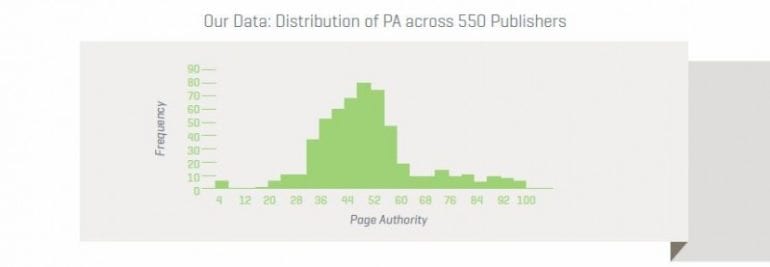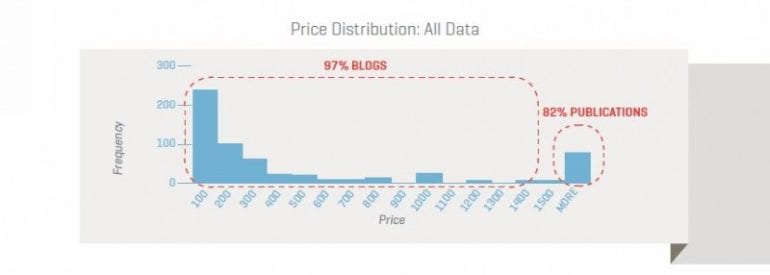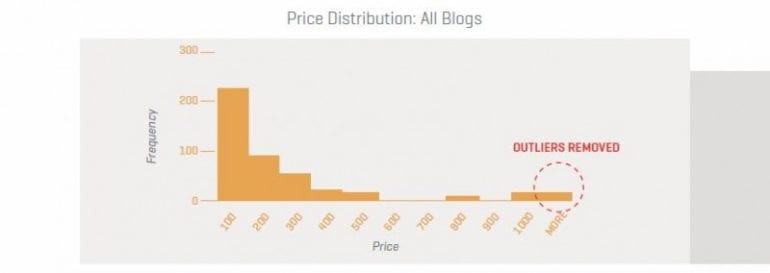Many of the traditional channels for online content discovery are thoroughly understood and their adoption rates are high.
The readily accepted channels—from SEO and PPC to email and social media broadcasting—can deliver the best content to the right people at the right time. SEO and PPC, to email and social media broadcasting—can deliver the best content to the right people at the right time.
Today, however, the Internet is experiencing a deluge of content, and many channels for content discovery are bloated. More than 2.73 million blog posts are written and published daily. Many industries are experiencing a content surplus, making it even more challenging for marketers to get their content seen.
Social media networks like Facebook and Twitter are adjusting their algorithms to ensure the least amount of organic visibility for brands, too. Traditional paid media, such as banner advertising, is becoming less effective year-over-year because banner blindness runs rampant. According to Solve Media, you’re more likely to survive a plane crash than click on a banner ad.
That sounds farfetched until you look at the results from the Nielsen Norman Groups 2007 eyetracking study (shown below).

As a result, new techniques, tactics, and tools are cropping up and being used by marketers of all stripes to maximize the visibility of their content. There’s now an entire content promotion ecosystem. From influencer marketing to native advertising, brands are experimenting in new ways.
Many brands are sponsoring articles on blogs or other online publications with large preexisting audiences. According to the “ Content Promotion Manifesto,” brands spent on average 6.7 percent of their content marketing budgets on sponsored content in 2013. It’s trending upwards, too. From The New York Times to Forbes’ Brand Voice to WiredShopper, there’s no shortage of famous examples.
While advertorials have been around for decades, this top-of-the-funnel sponsored article channel is relatively new for many content marketers. Over the last year, we have received many questions from clients about sponsored content—questions about pricing, scale, value, and strategy. We struggled to answer most of them; there wasn’t anywhere to get answers.
Because of this, we decided to reach out to 550 online publications to gather as much information about their sponsored content programs as possible. We wanted to find out the following:
- An agreed upon definition for sponsored articles
- The current state of sponsored articles as a channel
- Examples of sponsored articles
- Sponsored article pricing and value
- A media buying strategy for sponsored articles
- Tools and platforms for sponsored articles
We quickly learned that sponsored content on blogs and other online publications, when viewed as a marketing channel, is very immature. Pricing doesn’t have much rhyme or reason, either. However, after collecting and interpreting data on 550 online properties, and dissecting countless native advertising studies, we hope to shine a light on a little-known content marketing channel.
The results of the study are outlined below.
Defining Sponsored Articles
With content marketing adoption rates so high, many brands are looking to native advertising to promote their content. The Interactive Advertising Bureau (IAB) defines native advertising as “paid ads that are so cohesive with the page content, assimilated into the design, and consistent with the platform behavior that the viewer simply feels that they belong.” According to the IAB, native advertising contains six different types of ad units: in-feed, promoted listings, in-ad with a native element, paid search, recommendation widgets, and custom.
Sponsored articles fall into the in-feed subgroup. However, so does promoted content on Facebook, LinkedIn, and Twitter. Because they appear within the normal content feed of the publisher, it doesn’t matter if the publisher is Facebook or BuzzFeed.
In other words, sponsored articles amount to advertising on a media outlet in the form of editorial content that looks like it’s supposed to be there. Brands value this because association with a publication and exposure to its audience can drive awareness, traffic, conversions, and leads.
While sponsored content appears in the form and function of the host content, it is definitely not considered as an advertisement despite the ‘sponsored’ tag that it comes with. It is created for an enhanced level of engagement and aimed at keeping the readers hooked on the page for an extended period. It provides a high level of value to readers just like native ads by educating them. There are dedicated teams used by marketers to create such content for their brand requirements.
Sponsored content is a great promotional tool as the restrictions are limited. The only thing that publishers must do is mark the post as sponsored. Even a call to action can be included in the post.
The Current State of Sponsored Articles
We uncovered lots of fascinating information about sponsored articles while conducting our research. They are actually an evolved version of what many marketers call advertorials, which have been around for decades. The biggest difference between the two is where the content resides in the customer buying journey. Advertorials are middle to bottom-of-the-funnel content.

On the other hand, sponsored articles strictly reside at the top of the funnel. Their purpose is to be helpful, entertaining, or both. Top-of-the-funnel content doesn’t appear to be salesy and brand-centric to the reader. It’s the rise of content marketing that helped move advertorials up the funnel. This helps brands become not just purveyors of goods and services, but a producer of ideas and a distributor of knowledge.
Controversy
Sponsored articles have received pushback from some publishers, brands, and consumers—and even government regulators who are concerned because the articles resemble editorial content. This can damage the editorial integrity of a publication, as well as a brand’s image.
Both publishers and marketers have a vested interest in not appearing to mislead consumers. Native advertising, in general, is misunderstood by many consumers and marketers. (That’s partly why we conducted this study.)
In the video below, John Oliver does a good job of articulating many consumers’ concerns regarding sponsored articles.
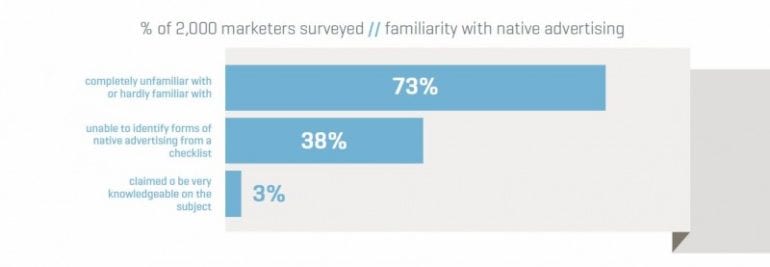 Thirty-eight percent of the marketers could identify forms of native advertising from a checklist, and only three percent claimed to be very knowledgeable.
Thirty-eight percent of the marketers could identify forms of native advertising from a checklist, and only three percent claimed to be very knowledgeable.
Earlier this year, Contently surveyed 542 U.S. Internet users to determine what they thought about sponsored articles. Only 48 percent of the respondents believed sponsored content that was labeled as such was paid for by an advertiser that had influenced the content produced. The rest thought the label meant something else.
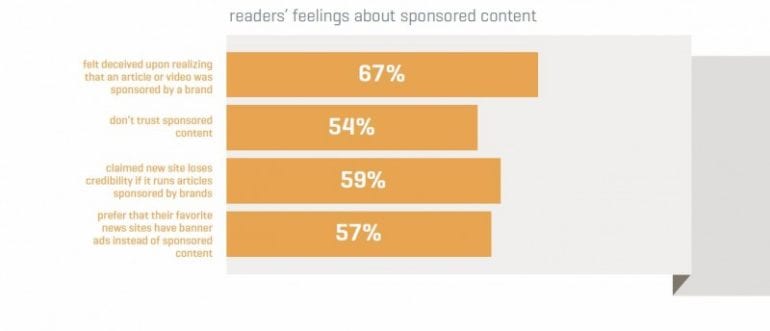 Just over 66 percent of the respondents reported they are not likely to click on an article sponsored by a brand and 33 percent said they’re just as likely to click on a sponsored article as they are to click on (unsponsored) editorial content.
Just over 66 percent of the respondents reported they are not likely to click on an article sponsored by a brand and 33 percent said they’re just as likely to click on a sponsored article as they are to click on (unsponsored) editorial content.
There is also contradictory evidence surrounding the overall effectiveness of sponsored articles. Research from Chartbeat shows that only 24 percent of visitors scroll past the fold when visiting a sponsored article—compared with 71 percent for editorial content.
However, The New York Times claims readers spend the same amount of time on sponsored articles as traditional news stories. This is backed up by a study from Sharethrough and IPG Media Labs. They found that consumers actually look at sponsored articles more than typical editorial articles (26 percent vs. 24 percent) and spend a similar amount of time on each (1 minute vs. 1.2 minutes).
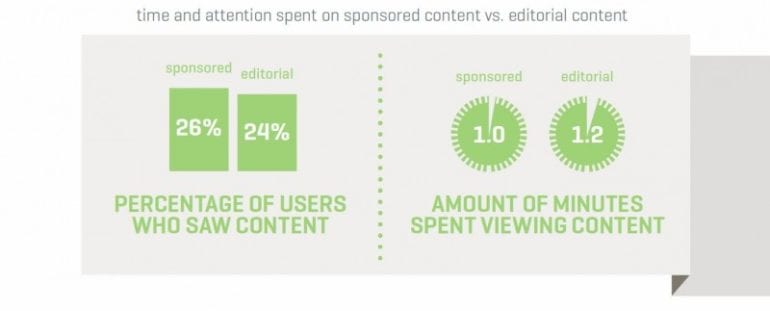 Not all publishers offer sponsored article opportunities to marketers. During our research, some respondents told us that protecting editorial integrity and preserving audience trust were higher priorities. On the other hand, many big name publishers like Forbes, The New York Times, Business Insider, The Atlantic, Washington Post and The Wall Street Journal have all embraced sponsored articles as a revenue source.
Not all publishers offer sponsored article opportunities to marketers. During our research, some respondents told us that protecting editorial integrity and preserving audience trust were higher priorities. On the other hand, many big name publishers like Forbes, The New York Times, Business Insider, The Atlantic, Washington Post and The Wall Street Journal have all embraced sponsored articles as a revenue source.
BuzzFeed’s entire business model is built around what it calls sponsored “listicles,” a.k.a. sponsored articles. While some publishers are averse to adopting this native form of advertising, it doesn’t seem to be causing any damage to the publishers who are using native ads.
The U.S. Federal Trade Commission (FTC) hasn’t quite figured out how to regulate native advertising. The FTC has delayed handing down regulations around disclosure requirements, language and graphic separation. Until that happens, the display of native advertising will remain at the discretion of publishers.
With that said, the IAB has set native advertising guidelines for its members. The IAB reports that clarity and prominence of paid native ad unit disclosure are vital, regardless of native advertising type.
Their two criteria are straightforward:
- Use language that conveys the advertising has been paid for, thus making it an advertising unit, even if that unit does not contain traditional promotional advertising messages.
- Be large and visible enough for a consumer to notice it in the context of a given page and/or relative to the device the ad is being viewed on.
In the case of sponsored articles, a reasonable consumer should be able to distinguish between editorial content from the publisher and paid advertising.
Growth
A 2013 survey conducted by Hexagram and Spada revealed that 62 percent of publishers had embraced sponsored articles, with another 16 percent planning to go this route by the end of 2014. Comparable research from eMarketer showed that only 10 percent of digital publishers didn’t have and weren’t considering native advertising on their sites.
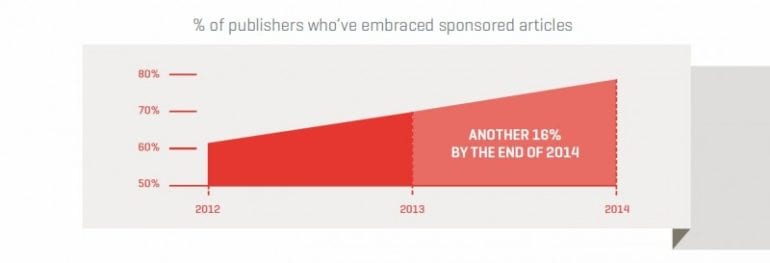 The 2014 Native Advertising Roundup revealed that 73 percent of media buyers use native advertising, and 93 percent expect to spend the same or more in the future. Native advertising spending in the U.S. is expected to increase from $1.3 billion in 2013 to $9.4 billion in 2018. A full 40 percent of publishers expect native advertising to drive a quarter or more of their digital revenue this year.
The 2014 Native Advertising Roundup revealed that 73 percent of media buyers use native advertising, and 93 percent expect to spend the same or more in the future. Native advertising spending in the U.S. is expected to increase from $1.3 billion in 2013 to $9.4 billion in 2018. A full 40 percent of publishers expect native advertising to drive a quarter or more of their digital revenue this year.
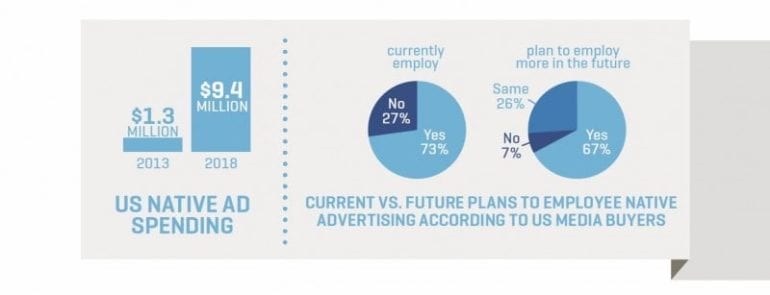 Native advertising, when compared to traditional display ads, have been found to be more effective. 25 percent more consumers looked at sponsored articles than display ad units. Native ads produced an 18 percent lift in purchase intent and a nine percent lift for brand affinity responses. BIA/Kelsey released a study which shows brands are planning on spending more on native advertising, and publishers stand to benefit as long as they can preserve the trust and interest of their audience.
Native advertising, when compared to traditional display ads, have been found to be more effective. 25 percent more consumers looked at sponsored articles than display ad units. Native ads produced an 18 percent lift in purchase intent and a nine percent lift for brand affinity responses. BIA/Kelsey released a study which shows brands are planning on spending more on native advertising, and publishers stand to benefit as long as they can preserve the trust and interest of their audience.
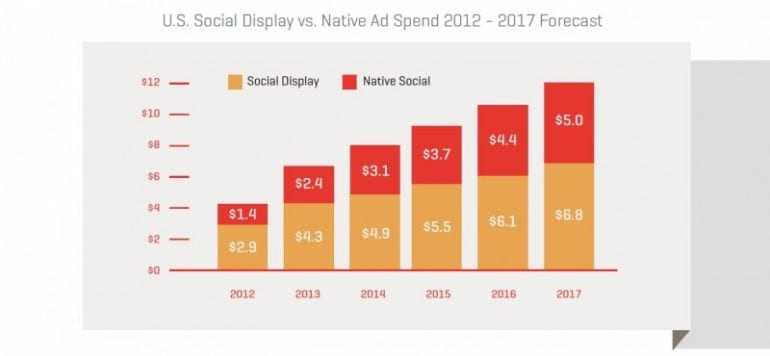 Examples of Sponsored Articles
Examples of Sponsored Articles
Since look, feel, design, language and requirements of sponsored content are left up to the discretion of publishers, the presentation of sponsored content on different sites varies widely. Some publications provide brands with what can be described as a virtual microsite within the site itself. Others are more streamlined, using an article that appears as a piece of featured content but is labeled as sponsored.
Any content can be labeled and categorized as sponsored provided it satisfies the key criteria of appearing as a seamless extension of the main content on the publisher website. It can be an article, a video, or a listicle and it has to appear as a native part of the content.
Many reputed publication houses have created content studios with the sole purpose of creating and hosting sponsored content. While being part of such an arrangement can cost you enormous sums of money, the benefits are huge too. The popular and highly expansive network of the publisher network can provide a readily available massive audience for a fraction of the price that advertisers would be otherwise spending.
Even print publications have identified the importance and lucrativeness of sponsored content and have dedicated sections for the same. These articles are posted using similar fonts, colors and other elements throughout the publication but there will be some distinguishing factor to mark it apart as sponsored.
Sponsored Article Pricing
There are no real standards for pricing in the digital world with regard to sponsored content. This makes budgeting for the channel very tough to do. It also makes long-term strategic execution at scale and across multiple publications a near impossibility.
While the value of sponsoring content is clearly understood by many brands, how to execute it and who to talk to in order to get it done is generally unclear. The study set out to add rhyme and reason to this burgeoning channel by exploring costs and comparing them across a broad spectrum of online publications and blogs.
This is valuable information for marketers and media buyers wishing to negotiate with online publications. It can even be used by publications that have not yet offered sponsored content opportunities to establish fair pricing.
Since publishers completely control their own pricing and standards, they maintain their own criteria for validating costs associated with sponsored articles. In today’s analytics-driven marketing culture, where channels are often compared and returns are measured, sponsoring content across several different publications can’t be so easily consolidated into a single “sponsored content” channel since each one has a unique value proposition.
This study is the industry’s first attempt to scientifically justify, quantify, and predict current going-rate prices of sponsored articles using explicit data points that can be measured for each online publication. Our goal was to create the first-ever quantitatively supported pricing standard for sponsored articles.
We hope our research puts an end to these challenges and empowers marketers with the ability to budget, negotiate, and ultimately scale the deployment of sponsored articles within their channel mix.
Research
In total, the research for this study was conducted over a five-month period of time earlier this year. It included manual outreach via email and phone to over 1,000 media outlets and blogs. The outreach resulted in responses from 550 publishers that sold sponsored article units.
The study took an unbiased approach to data inclusion and included a representative sample set. It collected data on globally-recognized publications, one-person blogs, and everything in between.
Publications were classified using the following criteria:
- Content is created by more than five writers/contributors/columnists, and:
- The website already utilizes traditional display advertising (e.g., banner ads)
Everything that didn’t meet the above criteria was classified as a blog.
Each price collected in the study was the minimum charge for getting a sponsored article published, regardless of other pricing factors. A total of 17 factors were cited as justification for pricing schemes from the 550 publishers.
- Word count: The number of words in a sponsored article
- User time on page: The amount of time a typical reader spends on a web page
- Links: Specifications regarding whether or not links would be provided, and if so, how many, where and whether or not they would be “nofollow” links
- Lead capture: For publishers that provide links to gated assets, many charge on a per-lead basis
- Impressions (CPM): Cost per thousand impressions based on historic data
- Time and effort required from publication’s editorial staff
- Monthly website traffic
- PageRank: Often used by publishers to justify relative pricing when they run more than one media outlet
- Domain Authority: Often used for publishers to justify relative pricing when they own more than one publication
- Page-level engagement: A metric that is measured by how far readers scroll down the page and the amount of time spent on a given article
- Social media promotion: Often an optional add-on that would increase price (may come as part of a package deal)
- Email promotion: Often an optional add-on that would increase price (may come as part of a package deal)
- Display advertising: Often an optional add-on that would increase price (may come as part of a package deal)
- Number of articles: How many sponsored articles you are buying at a time
- Visibility time: The amount of time an article stays live on the site
- Verticals: For large publications that cover many verticals or subject areas, some verticals are more expensive than others
- Pay-per-click: Another engagement-level metric that is measured by the number of click-throughs to an intended landing page
In order to do a quantitative analysis, explicit data was collected from all of the publications to calculate predictor variables. Those variables included:
- Domain Authority: A ranking score from Moz, on a 100-point scale, that uses more than 40 signals to calculate how well a website will perform in the search engine results pages (SERPs). The higher the score, the more authoritative the website is viewed as being.
- Page Authority: Another ranking score from Moz, on a 100-point scale, that calculates how well a given webpage is likely to rank in the SERPs. In the case of this study, the publication’s home pages were used.
- PageRank: A ranking metric from Google that calculates the relevance of a webpage. This score analyzes the number of incoming links and the quality of the referring webpages to generate a measurement between 0 (low relevance) and 10 (high relevance).
- AlexaRank: A ranking score from Alexa.com that is based on traffic data from users over a rolling three-month period. A site’s ranking is based on a combined measure of unique visitors and page views. The site with the greatest combination of these is ranked No. 1, and higher number rankings correlate with lower traffic data.
- Facebook Following: The number of fans (or “likes”) a publication’s Facebook page has.
- Twitter Following: The number of followers a publication’s or a blogger’s Twitter account has. For publications with multiple accounts and/or contributing authors, only the account with the largest following was used.
- Pinterest Following: The number of followers a publication’s or a blogger’s Pinterest account has.
Assumptions
It is assumed that the data set in this study is a representative sample of the entire ecosystem of blogs and other online publications because the results closely mirror Moz’s distribution of Page Authority that analyzed more than 10,000 SERPs and 200,000 unique pages. This regression model had a mean (average) Page Authority of 40.8 and standard deviation of 15.1. The distribution can be seen below.
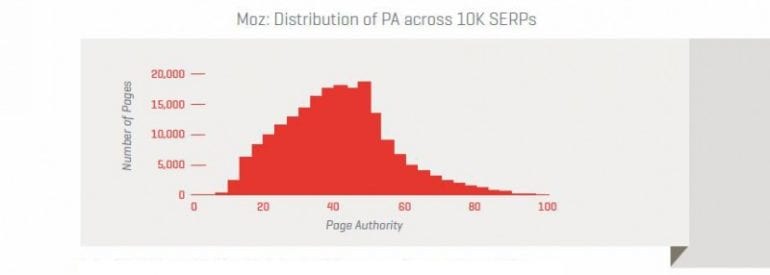 The regression model in this study had a mean of 47.1 and a standard deviation of 15.5. The sample set of blogs and publications had a slightly higher Page Authority than the Moz study. This was expected because the study only measured root domains and not long-tail pages within those domains.
The regression model in this study had a mean of 47.1 and a standard deviation of 15.5. The sample set of blogs and publications had a slightly higher Page Authority than the Moz study. This was expected because the study only measured root domains and not long-tail pages within those domains.
Aside from that slight disparity, the distribution curves are nearly identical. For those readers who are number junkies, the descriptive statistics of the Page Authority data in the study are below.
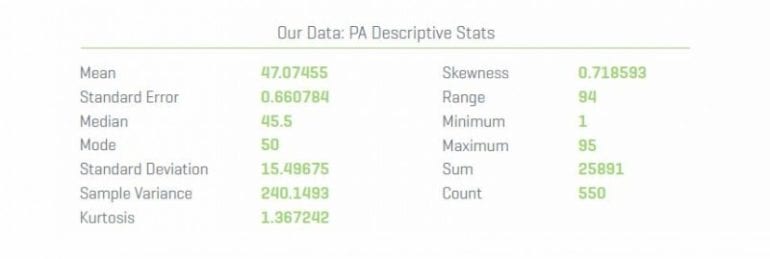 Limitations
Limitations
Variations in sponsored content offerings – The study established the pricing baseline based on the cost of one sponsored article. Since some publications only offered long-term commitments to marketers that could include other benefits (banners, email, social promotion, etc.), some publications’ unit pricing could be inflated. As a result, the regression model may not be an accurate price predictor in all scenarios.
Social account data – Not all online publications have accounts on Facebook, Twitter, and Pinterest. In these cases, the number zero was used to quantify followers. Also, for publications with multiple accounts on the same network, the study measured the account with the most followers.
Alexa Rank Inaccuracies – Alexa admits publicly that there are limits to making judgments from its data. Sites with relatively low traffic may not be accurately measured by Alexa.
Analysis
The graph below seeks to show the exact methodology we used to conduct the sponsored content pricing study. Its purpose is to give readers confidence in our pricing models so they feel comfortable in adapting the formulas.
When all prices are graphed, bloat appears on each end of the pricing spectrum. In order to reconcile the dense areas, the study broke down the pricing data and regression models for blogs and publications separately.
The graph below represents the distribution of prices for all 474 blogs in the study.
Because of the wide range and low frequency of prices recorded in the “more” area, we decided to label these data points as outliers. By removing the outliers (approximately 3.8 percent of the sample) from the analysis, the variance decreased by 87 percent, making for a more accurate predictive model. All descriptive statistics for the blog data sample before and after removing the outliers were laid out in the study.
With the remaining 456 cases, a multi-variable regression test for price against all of the predictor variables was run, after which the insignificant variables were removed to formulate the pricing regression model for blogs, as shown below.
 The end results confidently determined the fair market price formula for a sponsored article on a blog:
The end results confidently determined the fair market price formula for a sponsored article on a blog:

Publication Pricing Analysis
The graph below represents the distribution of pricing for all 76 publications recorded in the study.
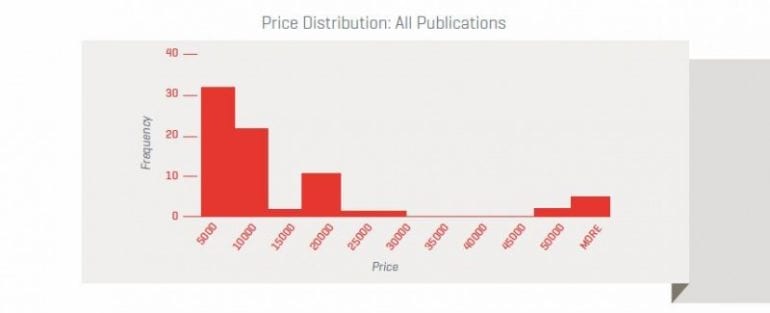 The outliers were kept in this regression model because of the range in quality and size of online publications is large. The descriptive statistics are available in the actual study.
The outliers were kept in this regression model because of the range in quality and size of online publications is large. The descriptive statistics are available in the actual study.
Following the same methods as the blog analysis, the study ran a multi-variable regression test to construct a predictive model for publication pricing. After removing the insignificant variables the output looks like this:
 The end result confidently determines the fair market price formula for a sponsored article on a publication:
The end result confidently determines the fair market price formula for a sponsored article on a publication:

What All This Math Really Boils Down To
With the formulas below, marketers now have a way to assign a value when purchasing or negotiating for sponsored articles on blogs or publications.
Prior to this study marketers had no way of knowing if they were getting a fair deal or not using this emerging channel.
- Blog Price Formula = -60.5 + 5.97(DA) + 0.978(thousand Fb fans) + 15.1(PR) – 0.000007(AR)
- Publication Price Formula = -37000 + 314(DA) + 20.9(thousand Fb fans) + 5152(PR) – 46.6(thousand Pinterest followers)
That said, media buyers should also note that many top-tier publications package their sponsored content offering in different ways. Keep this in mind when using the formulas above. Below are examples of some variation in sponsored article packages.

Networks and Tools for Sponsored Articles
While conducting research, several tools and networks kept coming up. Some networks set up for the sole purpose of connecting marketers with publishers for sponsored content. Even HubSpot has built an informal ad hoc network for its partner agencies to connect with its publishing customers. Content measurement tools, including Nudge, which was built to measure sponsored content, are starting to crop up, too.
A few other networks and tools worth noting:
- Adproval: A media outlet marketplace for connecting publishers and advertisers
- BlogHer: A blog and social media influencer community focused on social media coverage of women
- Blogsvertise: A blog marketplace for connecting publishers and advertisers
- Buysellads: A media outlet marketplace for connecting publishers and advertisers
- Cision: The brand’s Content Marketing Database includes a searchable database of over 2,000 sponsored opportunities with thousands of U.S. publications
- GroupHigh: Blogger outreach marketing software that helps companies find bloggers, in addition to managing and tracking relationships, and measuring results
- Izea: A sponsorship marketplace that connects social media influencers with brands
- Markerly: A brand amplification platform that connects brands with bloggers
- Sway Group: Connects brands and agencies with the largest network of female bloggers on the Web
- The Syndicate: A brand storytelling partner and blog sponsorship network.
It has been established beyond doubt by several studies that consumers remember branded content for a longer time when compared to a traditional advertisement. If you are keen to experiment with this strategy, but find it difficult to garner the resources and set aside time for the purpose, then the best way to make it happen is to sponsor content from third party sources or influencers.
Sponsored content is not something that has popped up suddenly in recent years. It has been around for decades since the time of print publications. The trend has now moved to the web too as online marketing has begun domination the content scene. Now even social media platforms are full of sponsored content.
Sponsored content is legally considered a form of advertising and subject to explicit guidelines. It is mandatory for publishers to follow the requisite online advertising and marketing guidelines as stated by law and applicable to the platforms they are using.
However, sponsored content on social media is a tricky thing. Brands have to clearly and explicitly state that they have a monetary connection to the content. Companies must disclose that they have paid or received money for an endorsement. Brands are using hashtags to demarcate sponsored content on social platforms so that consumers are aware of the promotional aspect.
Some of the key guidelines that must be unfailing complied with while posting or publishing sponsored content are:
- There must not be any misleading claims or lies
- A clear disclosure of the sponsor must be made and in a font that is legible
- A note that content is sponsored or promoted must appear in the post itself
With the growth of online content showing no signs of slowing, the use of sponsored content as a marketing channel will undoubtedly continue to grow as well. Besides, it’s a proven revenue stream for publishers who have often struggled to make money on the Internet.
However, as the popularity of sponsored content grows, so does the likelihood of it being regulated by governments. Until then, consider this post your definitive guide to sponsored content. The study can be downloaded here.


